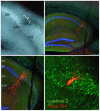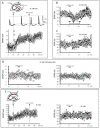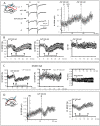Vasopressin inhibits LTP in the CA2 mouse hippocampal area
- PMID: 23236353
- PMCID: PMC3517623
- DOI: 10.1371/journal.pone.0049708
Vasopressin inhibits LTP in the CA2 mouse hippocampal area
Abstract
Growing evidence points to vasopressin (AVP) as a social behavior regulator modulating various memory processes and involved in pathologies such as mood disorders, anxiety and depression. Accordingly, AVP antagonists are actually envisaged as putative treatments. However, the underlying mechanisms are poorly characterized, in particular the influence of AVP on cellular or synaptic activities in limbic brain areas involved in social behavior. In the present study, we investigated AVP action on the synapse between the entorhinal cortex and CA2 hippocampal pyramidal neurons, by using both field potential and whole-cell recordings in mice brain acute slices. Short application (1 min) of AVP transiently reduced the synaptic response, only following induction of long-term potentiation (LTP) by high frequency stimulation (HFS) of afferent fibers. The basal synaptic response, measured in the absence of HFS, was not affected. The Schaffer collateral-CA1 synapse was not affected by AVP, even after LTP, while the Schaffer collateral-CA2 synapse was inhibited. Although investigated only recently, this CA2 hippocampal area appears to have a distinctive circuitry and a peculiar role in controlling episodic memory. Accordingly, AVP action on LTP-increased synaptic responses in this limbic structure may contribute to the role of this neuropeptide in controlling memory and social behavior.
Conflict of interest statement
Figures



References
-
- Van Wimersma Greidanus TB, De Wied D (1980) Physiological significance of neurohypophyseal hormones in memory processes. Acta Psychiatr Belg 80: 721–727. - PubMed
-
- Bao AM, Meynen G, Swaab DF (2008) The stress system in depression and neurodegeneration: focus on the human hypothalamus. Brain Res Rev 57: 531–553. - PubMed
-
- Frank E, Landgraf R (2008) The vasopressin system–from antidiuresis to psychopathology. Eur J Pharmacol 583: 226–242. - PubMed
-
- Surget A, Belzung C (2008) Involvement of vasopressin in affective disorders. Eur J Pharmacol 583: 340–349. - PubMed
Publication types
MeSH terms
Substances
LinkOut - more resources
Full Text Sources
Miscellaneous

